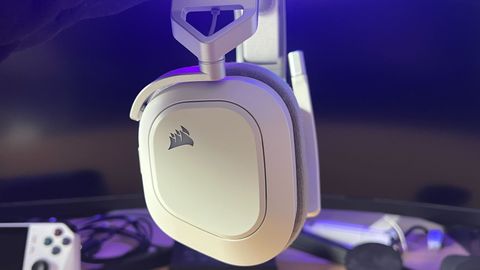12DOVE Verdict
The Corsair HS80 Max does exactly what a mid-range headset should. This thing nails the basics with a rich soundstage and excellent balancing, but can struggle in other areas. The microphone doesn’t hold up to the competition, and the lack of simultaneous connections is disappointing considering the price. However, with excellent battery life, Dolby Atmos surround sound, and a rock-solid build quality this is still a fantastic option.
Pros
- +
Rich, textured audio
- +
Comfortable cup design
- +
Durable build quality
- +
Excellent straight out of the box
- +
Free Dolby Atmos surround
Cons
- -
Lower quality microphone
- -
Sometimes uncomfortable ski-band
- -
No simultaneous connection
Why you can trust 12DOVE
Corsair’s HS80 headset delighted back in 2021. Its well-tuned audio, lower mid-range price tag, and comfortable shape set it apart from the rest of its cohort and set the series up for excellent long-term use. The newer Corsair HS80 Max certainly leans into these strengths in its latest iteration, even if some of its weaknesses are still fairly pronounced. A PC / PlayStation headset prioritizing easy wireless connections and rich audio texture, the Max has plenty going for it straight out the box. I took the 2023 model out for two weeks of testing to see where the brand’s geometric cups sit within the best gaming headsets on the market.
| Price | $179.99 / £169.99 |
| Connection | 2.4GHz / Bluetooth |
| Drivers | Custom 50mm Neodymium |
| Frequency response | 20Hz - 20kHz |
| Microphone | Omni-directional |
| ANC | No |
| Controls | Power, volume wheel, Bluetooth / media controls |
| Battery | Up to 130 hours (no RGB, Bluetooth connection) |
| Weight | 352g |
| Compatibility | PC, PlayStation, Nintendo Switch, Mobile |
Design
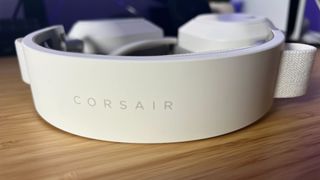
At first glance, the Max could be indistinguishable from the previous Corsair HS80 RGB release. Both carry the angled cup shapes that have become ubiquitous with the HS80 name itself and offer a comfortable housing for the ear itself, rather than squishing it into a circular form factor. That means no ear-pinching, even over longer sessions, but a spacious seal around the shape of the ear.
Soft fabric covers a set of memory foam cushions around the border of these cups - perfect for those who don’t get on with the sometimes sticky feel of the leatherette often included on more premium headsets. The fabric cover does still warm up, but things are much cooler here than, say, the Corsair Virtuoso RGB Wireless XT or Turtle Beach Stealth Pro. However, the seal maintained by this lighter fabric isn’t quite as solid as you’ll find with a denser material and the cloth could likely erode over time.
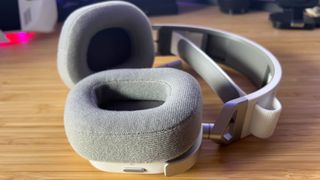
You will find a dash of leatherette running across the ski-style headband, providing a slight cushioning to the inner strap. This band is adjustable via velcro pads on the underside of the main plastic bridge. While a neat way to keep a fabric band in place, I prefer a sliding scale as it’s difficult to perfectly balance each side when simply relying on eyeballing each side. This design also means material hangs over the sides of the headset when not worn should you increase the headband size.
The strap itself carries some strong tension in its elastic, keeping the head protected from the harder plastic above. It’s also a little slimmer than other ski bands, most notably those from SteelSeries. That does put a little more pressure on the crown than a more cushioned approach, which did wear on me a little during longer periods of testing.
I found myself shifting the position of the headband a few times after around two hours of wear, seating it forward or backward on my head to give each area a break. Lengthening the strap helped this problem, but resulted in additional pressure from the cups themselves falling too low over my ears. If you’re used to ski bands, this isn’t going to be a massive issue, but anyone coming from a wider band like the SteelSeries Arctis Nova Pro Wireless is going to feel it slightly.
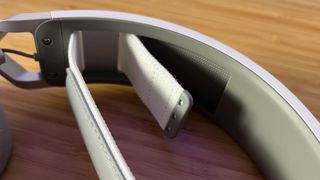
At 352g, the Corsair HS80 Max sits at the higher end of average, but the plastic construction saves it from feeling like a dead weight across the noggin. That trade-off doesn’t come with too many sacrifices either. No, it doesn’t look like a seriously expensive headset, but I have no concerns with the overall build quality and everything feels solid and secure with no creaking or flexing. The only points of damage could be in the material of the earcups and the velcro of the headband over time, as well as the thin wire leading from the main drivers to the band itself. These are shielded somewhat by a thick triangular piece of plastic, but I would still be wary of throwing them into a particularly stuffed backpack.
Features
The Corsair HS80 Max doesn’t do anything too crazy with its feature list. This is a wireless headset with both 2.4GHz and Bluetooth (though no dual-connectivity for simultaneous listening), 50mm neodymium drivers, and a flip-to-mute microphone. However, there are a couple of additional extras included here that you might not find on competing models. The Bluetooth connection button, for example, doubles up as a playback center, allowing you to play/pause, move between tracks, and control incoming calls via a series of single, double, or triple presses.
That’s not something I see too often in a gaming headset, and it’s a feature that lends itself particularly well to those who want to double up their purchase for a regular set of everyday headphones. This would be a much bigger deal if the microphone had been detachable, though. As it stands, you’ll be walking around town with a giant wedge of plastic up the side of your face which isn’t ideal.
Still, the battery life could keep up with both gaming and everyday roles. Corsair estimates that you’ll get 130 hours of juice when connected via Bluetooth and no RGB - a figure that proved true in my testing. I ran the headset in Bluetooth mode for one week, using the headset for music throughout the day, the odd meeting, and gaming or Netflix in the evening. That equated to around 6-8 hours of use per day, and the battery was still at 78% on Saturday morning. A second week of testing solely on a 2.4GHz connection did yield lower results. I switched the RGB on for the full power-draining experience and needed to recharge by Wednesday, running the headset for around two and a half days, or 17.5 hours before plugging in.
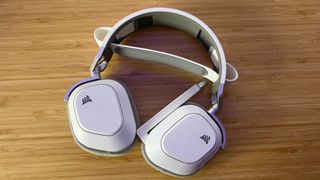
The HS80 Max also comes with a free Dolby Atmos license inside the box and supports high-resolution signals up to 24bit / 96kHz. That’s a marked step up from similarly priced options, and well worth noting if you’re after a more faithful representation of songs and movies even if frequency responses are run of the mill.
Booting up the iCue software also reveals another fancy addition to the Max’s soundstage; SoundID. While its setup feels a little like smoke and mirrors, the program is designed to create an audio preset tailored to your own preferred listening style. For me, that meant bumping up the power of lower ranges and expanding room in the mids. It does make a difference to the overall soundstage but doesn’t massively alter the quality of the audio coming through. I noticed a beefier response from explosions and heavier artillery, but not much that couldn’t be achieved with simple EQ tweaks.
Performance
Straight out of the box, the Corsair HS80 Max performs particularly well. There’s a richer tone to this audio than I’ve heard before, with emphasis on the lower mid-range. While there’s not much space in the stage itself, those bassier areas really shine through providing excellent punch to heavy sound effects. That warmth does mean you lose a little power in the upper ranges. The twinkly, melodic soundtrack of Super Mario RPG felt a little cramped, though with the volume pumped up and some EQ settings tweaked it became apparent that there’s actually a lot of clarity in these higher tones.
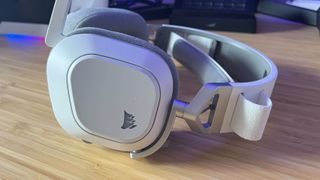
In experiences where the HS80 Max can shine, it does. The open-world environments of Fallout 4 and Horizon Forbidden West are bursting with life through these cups, from the definition of smaller details to the power of larger crashes and gunfights. Watching the Brotherhood of Steel descend for the first time through the HS80 Maxs was a particularly impressive ordeal. There’s a texture to the mid-range that is often difficult to balance. Many gaming headsets opt to put their emphasis on lower ranges, paying more attention to footsteps and gunshots in their sound profiles. While that attention has been dutifully paid here (not quite with the directional accuracy of something wildly more expensive like the Audeze Maxwell or Astro A50 X), it’s in dialogue, soundtracks, and the crunch of a gravel road beneath your feet that the HS80 Max truly weaves its magic.
The microphone is a little jarring in comparison. This is a weaker mic that will simply get the job done rather than providing high-end broadcast-quality sound. It’s far flatter than the Razer BlackShark V2 Pro’s model and has a little more noise so its profile overall.
Should you buy the Corsair HS80 Max?

The Corsair HS80 Max launched last year at $179.99 / £169.99, but it can be found at around $150 when on sale these days (the UK has seen its own discounts but they’re not as frequent). Those kinds of numbers put the Max up against the Sony Inzone H5 for PS5/PC players, but we’ve also got the slightly more expensive Corsair Virtuoso Pro and the slightly cheaper Razer BlackShark V2 Hyperspeed to contend with.
The latter is currently my top pick for the best headset for most players. It’s substantially cheaper than the HS80 Max at MSRP and packs a better microphone, a wired USB-A connection option, and an audio better suited to more competitive play. If you don’t mind leatherette earcups, it’s the better headset on paper - just be wary that the build quality isn’t quite as strong. The microphone still doesn’t detach (and doesn’t even flip up on the BlackShark) but does perform much better than Corsair’s. If you just want your gaming headset to stay on your desk, the BlackShark is the better option. However, if you’re going to take your cups out and about, Corsair does still have an edge.
The Virtuoso Pro is just edging on the HS80 Max’s price point, at $199.99 / £169.99, and is generally a better headset overall. However, the open-back nature means it’s strictly for home use (and use in a quiet room), there’s no wireless connectivity, and you’ll be faffing with a few cables to get everything set up. That means it’s not the best option for the vast majority of players - if you’re not a streamer, you’re better off with the HS80 Max.
The Sony Inzone H5 is more of a direct competitor in price these days, and an option I personally found more comfortable than the ski-band design of the HS80 Max. You’re dropping your battery life and killing Bluetooth features, but still keeping a richly textured soundstage similar to that of the Max. If you’re concerned about comfort across the crown of your head, this is my next go-to - though you are making a lot of sacrifices in other areas.
| Specs | Corsair HS80 Max | Razer BlackShark V2 Hyperspeed | Sony Inzone H5 |
|---|---|---|---|
| Price | $179.99 / £169.99 | $129.99 / £129.99 | $149.99 / £139.99 |
| Connection | 2.4GHz / Bluetooth | 2.4GHz / Bluetooth / Wired | 2.4GHz / Wired |
| Drivers | Custom 50mm Neodymium | Razer TriForce Titanium 50mm | 40mm |
| Frequency response | 20Hz - 20kHz | 12Hz - 28kHz | 5Hz - 20kHz |
| Microphone | Omni-directional | Super Wideband Unidirectional | Bidirectional with AI noise reduction |
| ANC | No | No | No |
| Controls | Power, volume wheel, Bluetooth / media controls | Power, volume, playback, profile / Bluetooth smartswitch, mic mute | Power, volume, chat mix |
| Battery | Up to 130 hours (no RGB, Bluetooth connection) | Up to 70 hours | Up to 28 hours |
| Weight | 352g | 280g | 260g |
| Compatibility | PC, PlayStation, Nintendo Switch, Mobile | PC, PlayStation, Nintendo Switch, Mobile | PC, PlayStation |
How we tested the Corsair HS80 Max
I used the Corsair HS80 Max for two weeks, running the headset across all daily work and play. In that time, I tested across both a 2.4GHz and Bluetooth connection, using the headset in Fallout 4, Assassin’s Creed Odyssey and New Super Lucky’s Tale on PC, Horizon Forbidden West and Spider-Man Miles Morales on PS5, and Super Mario RPG on Nintendo Switch. For more information on how we test gaming headsets, check out the full 12DOVE Hardware Policy.
We’re also rounding up all the best wireless gaming headsets on the market, as well as the best PC headsets for gaming. Or, take a look at the best PS5 headsets if you’re after something more console-focused.

Managing Editor of Hardware at 12DOVE, I originally landed in hardware at our sister site TechRadar before moving over to GamesRadar. In between, I've written for Tom’s Guide, Wireframe, The Indie Game Website and That Video Game Blog, covering everything from the PS5 launch to the Apple Pencil. Now, i'm focused on Nintendo Switch, gaming laptops (and the keyboards, headsets and mice that come with them), PS5, and trying to find the perfect projector.

Kinds of Kindness review: "Yorgos Lanthimos' hollow film feels like a test for audiences"

Yes, that is Doctor Who’s new season 2 companion in Boom – but the mystery cameo leaves us with more questions than answers

Former XCOM boss Jake Solomon says he doesn't play XCOM-likes, but "Into the Breach is incredible" and he's honored to have inspired it: "I'll put that on my resume"
